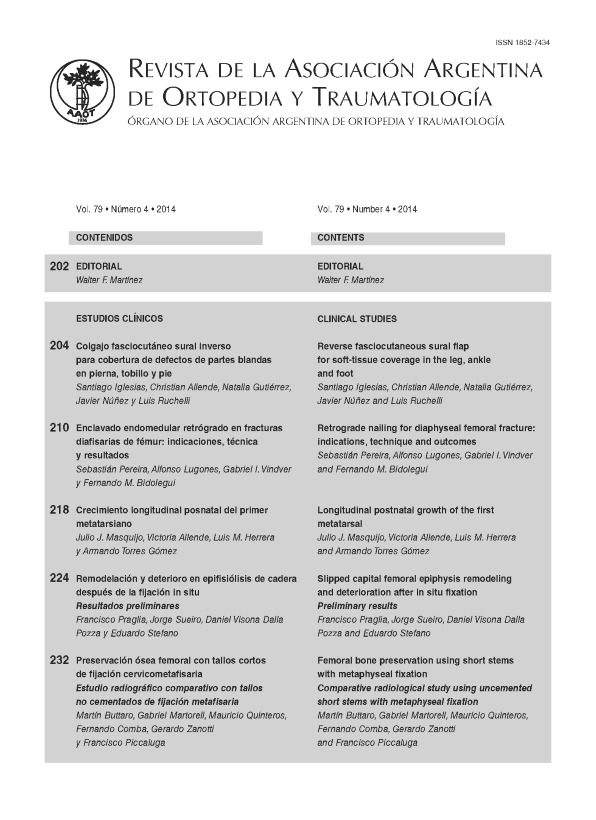Slipped capital femoral epiphysis remodeling and deterioration after in situ fixation Preliminary results
Main Article Content
Abstract
Downloads
Metrics
Article Details

This work is licensed under a Creative Commons Attribution-NonCommercial-ShareAlike 4.0 International License.
Manuscript acceptance by the Journal implies the simultaneous non-submission to any other journal or publishing house. The RAAOT is under the Licencia Creative Commnos Atribución-NoComercial-Compartir Obras Derivadas Igual 4.0 Internacional (CC-BY-NC.SA 4.0) (http://creativecommons.org/licences/by-nc-sa/4.0/deed.es). Articles can be shared, copied, distributed, modified, altered, transformed into a derivative work, executed and publicly communicated, provided a) the authors and the original publication (Journal, Publisher and URL) are mentioned, b) they are not used for commercial purposes, c) the same terms of the license are maintained.
In the event that the manuscript is approved for its next publication, the authors retain the copyright and will assign to the journal the rights of publication, edition, reproduction, distribution, exhibition and communication at a national and international level in the different databases. data, repositories and portals.
It is hereby stated that the mentioned manuscript has not been published and that it is not being printed in any other national or foreign journal.
The authors hereby accept the necessary modifications, suggested by the reviewers, in order to adapt the manuscript to the style and publication rules of this Journal.
References
1991;73:667-74.
2. Loder RT, O’Donnell PW, Didelot WP, Kayes KJ. Valgus slipped capital femoral epiphysis. J Pediatr Orthop 2006;26:594-600.
3. Muller W. Eieentstehung von coxa valga durch epiphy sen verschiebung. Beitr Z Klin Chi. 1926;137:148-64.
4. Hartjen CA, Koman LA. Treatment of slipped capital femoral epiphysis resulting from juvenile renal osteodysthrophy. J Pediatr
Orthop 1990;10:551-4.
5. Aronson DD, Carlson WE. Slipped capital femoral epiphysis. A prospective study of fixation with a single screw. J Bone Joint
Surg Am 1992;74:810-9.
6. Boyer DW, Mickelson MR, Ponseti IV. Slipped capital femoral epiphysis. Long-term follow-up of one hundred and twenty-one
patients. J Bone Joint Surg Am 1981;63:85-95.
7. Loder RT, Richards BS, Shapiro PS, Reznick LR, Aronson DD. Acute slipped capital femoral epiphysis. The importance of
physeal stability. J Bone Joint Surg Am 1993;75:1134-40.
8. O’Brien E, Fahey J. Remodeling of the femoral neck after in situ pinning for slipped capital femoral epiphysis. J Bone Joint
Surg Am 1977;59:62-8.
9. Larson AN, Sierra RJ, Yu EM, Trousdale RT, Stans AA. Outcomes of slipped capital femoral epiphysis treated with in situ
pinning. J Pediatr Orthop 2012;32:125-30.
10. Karol LA, Doane RM, Cornicelli SF, Zak PA, Haut RC, Manoli A 2nd. Single versus double screw fixation for treatment of
slipped capital femoral epiphysis: a biomechanical analysis. J Pediatr Orthop 1992;12:741-5.
11. Waldenström H. Slipping of the upper femoral epiphysis. Surg Gynecol Obstet 1940;71:198.
12. Fahey J, O’Brien E. Acute slipped capital femoral epiphysis. J Bone Joint Surg Am 1965;47:1105-27.
13. Hall JE. The results of treatment of slipped femoral epiphysis. J Bone Joint Surg Br 1957;39:659-73.
14. Harris WH. Traumatic arthritis of the hip after dislocation in acetabular fractures. Treatment by mould arthroplasty. J Bone Joint
Surg Am 1969;51:737-55.
15. Clohisy JC, Carlisle JC, Beaulé PE, Kim YJ, Trousdale RT, Sierra RJ, et al. A Systematic approach to the plain radiographic
evaluation of the young adult hip. J Bone Joint Surg Am 2008;90(Suppl 4):47-66. doi:10.2106/JBJS.H.00756.
16. Leunig M, Casillas MM, Hamlet M, Hersche O, Notzli H, Slongo T, Ganz R. Slipped capital femoral epiphysis: early
mechanical damage to the acetabular cartilage by a prominent femoral metaphysis. Acta Orthop Scand 2000;71:370-5.
17. Ganz R, Gill TJ, Gautier E, Ganz K, Krugel N, Berlemann U. Surgical dislocation of the adult hip a technique with full access
to the femoral head and acetabulum without the risk of avascular necrosis. J Bone Joint Surg Br 2001;83:1119-24.
18. Leunig M, Slongo T, Kleinschmidt M, Ganz R. Subcapital correction osteotomy in slipped capital femoral epiphysis by means
of surgical hip dislocation. Oper Orthop Traumatol 2007;19:389-410.
19. Leunig M, Slongo T, Ganz R. Subcapital realignment in slipped capital femoral epiphysis: surgical hip dislocation and trimming
of the stable trochanter to protect the perfusion of the epiphysis. Instr Course Lect 2008;57:499-507.
20. Ganz R, Huff T, Leunig M. Extended retinacular soft tissue flap for intraarticular surgery of the hip. Operative technique,
indications and results of its application. Clin Orthop Relat Res 2009;467(3):704-716.
21. Spencer S, Millis MB, Kim YJ. Early results of treatment of hip impingement syndrome in slipped capital femoral epiphysis and
pistol grip deformity of the femoral head-neck junction using the surgical dislocation technique. J Pediatr Orthop 2006;26:281-5.
22. Praglia F, Sueiro J, Visona Dalla Pozza D, Stefano E. Deslizamientos epifisarios femorales proximales >30°. Procedimiento
de Dunn modificado. Evaluación anatomía y funcional en una cohorte retrospectiva. Rev Asoc Argent Ortop Traumatol 2013;
78(4):199-209.
23. Clarke NMP, Harrison MHM. Slipped upper femoral epiphysis. A potential for spontaneous recovery. J Bone Joint Surg Br
1986;68(4):541-4.
24. Siegel DB, Kasser JR, Sponseller P, Gelberman RH. Slipped capital femoral epiphysis a quantitative analysis of motion, gait,
and femoral remodeling after in situ fixation. J Bone Joint Surg Am 1991;73:659-66.
25. Wong-Chung J, Strong ML. Physeal remodeling after internal fixation of slipped capital femoral epiphysis. J Pediatr Orthop
1991;11:2-5.
26. Bellemans J, Fabry G, Molenaers G, Lammens J, Moens P. Slipped capital femoral epiphysis: a long-term follow-up, with
special emphasis on the capacities for remodeling. J Pediatr Orthop B 1996;5:151-7.
27. Slongo T, Kakaty D, Krause F, Ziebarth K. Treatment of slipped capital femoral epiphysis with a modified Dunn procedure.
J Bone Joint Surg Am 2010;92:2898-908. doi:10.2106.
28. Sink EL, Zaltz I, Heare T, Dayton M. Acetabular cartilage and labral damage observed during surgical hip dislocation for stable
slipped capital femoral epiphysis. J Pediatr Orthop 2010;30:26-30.
29. Larson AN, Sierra RJ, Yu EM, Trousdale RT, Stans AA. Outcomes of slipped capital femoral epiphysis treated with in situ
pinning. J Pediatr Orthop 2012;32:125-30.

